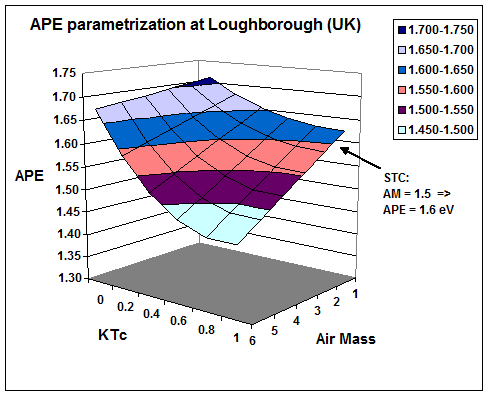Spectral characterization: Average Photon Energy (APE)
The "Average Photon Energy" is aiming to the characterization of the energetic distribution in an irradiance spectrum. It is obtained by dividing the irradiance [W/m² or eV/m²/sec] by the photon flux density [number of photons/m²/sec].
From detailed spectral measurements over one year performed at Loughborough, the CREST1 has deduced a parametrization of this quantity according to:
- The relative air mass, which, in its simpler form is expressed as AM = 1/cos z, with z = zenith angle.
- The atmosphere transmission according to the weather, usually expressed with the clearness index Kt, ratio between the horizontal global and the irradiance outside the atmosphere. But as the clearness index is not independent of the air mass (depends on the sun height), CREST has chosen to use a clearness index normalized to clear sky conditions Ktcs.
But while CREST determines the "clear sky" conditions by adjusting an exponential on the higher global values observed as function of air mass, in PVsyst we can use the "Clear Sky Model".
This parametrization looks like the following:
The "standard" spectrum AM 1.5 corresponds to APE = 1.6 eV. In the English climate, the annual distribution of APE is a bell-shaped curve, centered on 1.65 eV and with a half-height width of about +/-0.08 eV.
By clear days, the APE diminishes (shift to the red) when the sun height decreases. Cloudy spectra are rather characterized by spectra shifted to the blues (more favorable for amorphous modules).
-
T.R. Betts, R. Gottschalg, D.G. Infield
Spectral Irradiance Correction for PV system Yield Calculations.
19th European Photovoltaic Solar Energy Conference, Paris, June 2004. ↩
